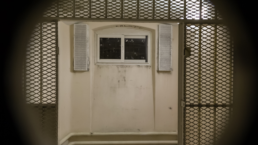As the state keeps details around the death penalty hidden, an investigation into its execution team raises questions about how incarcerated people are treated in their final moments.
By Lauren Gill and Daniel Moritz-Rabson, Bolts
As the leader of Alabama’s execution team, Brandon McKenzie is sometimes the last person to touch a prisoner while they’re still alive. He has played a key role in executions, directing a team of around a dozen prison guards on execution nights and performing tasks that can impact how long it takes for someone to die or whether they feel pain.
Alabama prison officials gave McKenzie these responsibilities even after a prisoner accused the guard of smashing his head through a window, then driving him head-first into a concrete floor.

The injuries McKenzie inflicted were severe and lasting, according to a federal civil rights lawsuit filed by the prisoner, Lawrence Phillips, in May 2020. Phillips lost consciousness and was taken from Holman Correctional Facility in Atmore to a Mobile hospital. Medical records show he was treated for bleeding in his brain and received sutures, staples, and a neck brace.
“I’ve not been the same since, and my memory fades in and out at the time,” Phillips wrote in his complaint. “I have nightmares, accompanied with post traumatic stress from the fears of this happening to me again.”
McKenzie, who was promoted to captain two months after Phillips filed the lawsuit, claimed that he was acting in self-defense; attorneys from the state who represented the officer wrote in a legal filing that Phillips “angrily lunged” at McKenzie, who reacted by “using his elbow to protect himself and push inmate Phillips away, and they then collided with a glass window nearby.” Another incarcerated person who witnessed the altercation submitted an affidavit supporting Phillips’s account.
Recent Posts
The “President Of Peace” Prepares For War
December 23, 2025
Take Action Now The Donroe Doctrine Hits HomeBy William D. Hartung, Tom Dispatch Earlier this month, the Trump administration released its new…
“Who Are They Protecting?”: Rep. Ro Khanna Urges Contempt Charges Over AG Bondi’s Epstein Redactions
December 22, 2025
Take Action Now “The House can act unilaterally on contempt, and this will be introduced by Thomas Massie. What the resolution will say is that…
Dems Demand Answers as Trump Photo Disappears From DOJ Online Epstein Files
December 21, 2025
Take Action Now “What else is being covered up?”By Brett Wilkins, Common Dreams Congressional Democrats on Saturday pressed US Attorney General…
Elon Musk Is Vowing Utopia Driven by AI and Robotics. Bernie Sanders Has a Few Questions
December 20, 2025
Take Action Now “I look forward to hearing about how you and your other oligarch friends are going to provide working people with a magnificent life…




